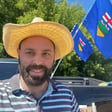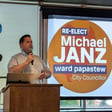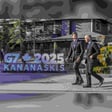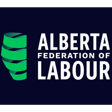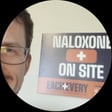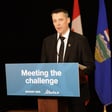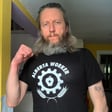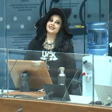Become a Creator today!Start creating today - Share your story with the world!
Start for free
00:00:00
00:00:01

Edmonton's Nazi-collaborator statue
Outside of the Ukrainian Youth Unity Complex in north Edmonton is a statue of Roman Shukheyvych--a Nazi collaborator who took part in the mass murder of Jews. Local activist Paula Kirman and host Duncan Kinney discuss Shukheyvych’s historical legacy with Per Anders Rudling, an expert on the Ukrainian far right.
Transcript
Introduction and Topic Overview
00:00:15
Speaker
Friends and enemies, welcome to the Progress Report. I am your host, Duncan Kinney. We're recording here today in Amiskwichiwa, Skigam, otherwise known as Edmonton, here on Treaty Six Territory. And today we're talking about, there's really no other way to put this, Edmonton's Nazi Collaborator Statue.
00:00:34
Speaker
Um, I don't know if you know this, it's not super widely known amongst around town, but yes, Edmonton has a statue of a Nazi collaborator, a man who participated in the Holocaust during World War II. His name is Roman
Guest Introductions
00:00:49
Speaker
Škiewicz, and his statue is outside of the Ukrainian Youth Unity Complex on the north side of Edmonton. It's a larger-than-life copper bust, and it was put up in the mid-1970s around the time that the building went up.
00:01:01
Speaker
To help us understand why this statue is here and the context around Ramage Kavich, we have on the line, Per Anders Redling. Per is an associate professor of history at the University of London, Sweden. He also has a PhD in history that he got at the University of Alberta, so he does have a bit of an Alberta connection.
Historical Background on Roman Škiewicz
00:01:18
Speaker
Per, welcome to the show. Thank you very much.
00:01:21
Speaker
To help us process this on the local side, we are also very lucky to have Paula Kerman on the show today. Paula is a communications professional and an award-winning journalist and community organizer. Paula, welcome to The Progress Report. Thanks, Duncan. Okay, so I've just put it out there straight up off the top. No kind of like skirting around it. Edmonton has a statue of a Nazi collaborator in it.
00:01:44
Speaker
And Per, you've done extensive research on Romanshikavich. During the research for this episode, I kind of referred extensively to your academic work on this subject. Why don't you just take a bit of time to put us in the mind of Romanshikavich? Where did he come from? What was his political ideology? What was his political project? And let's do all this pre-World War II before the Nazis showed up in the Ukraine.
00:02:07
Speaker
Well, the remarks of Khaled belong to a prominent family in what was called, and is still called, Galicia, the easternmost province of the Austrian Empire. Here, like many of its generations, generations were very frustrated with the failure to establish a Ukrainian state.
00:02:24
Speaker
He joined one of the most radical far-right movements in Ukraine, which later on
Škiewicz's Controversial Activities
00:02:30
Speaker
became known as the Organization of Ukrainian Nationalists, known as OUM, and he came to be one of the leading figures there. This organization believed in using terrorism to achieve Ukrainian state, Ukrainian states, ethnically,
00:02:47
Speaker
pure, effigy cleansed Ukraine, the Ukrainian state of Ukrainians, a one-party state, an authoritarian state. Increasingly, the Ulun, over the 1930s, oriented itself towards revisionist powers, not least Nazi Germany. And in 1939, 1940, 1941, Marshall Hevish was trained by Nazi Germany by the, by the upward military intelligence of Nazi Germany.
00:03:18
Speaker
And Roman, just to jump in here, Roman Shkaevich believed in violence to kind of achieve his political ends. He engaged in political terrorism from a young age, right?
00:03:28
Speaker
Well, he was involved in this first assassination at age 18 in 1926. The UN, it should be said, was a marginal group. It was a rather sectarian far-right group, and it did not command the support of most Ukrainians. But it was the most radical group on the Ukrainian political spectrum in the 1930s. And it believed, yes, in assassinating Polish government officials since
00:03:53
Speaker
headmasters at schools and whatnot, and bringing about a revolutionary situation in Poland so that Ukraine could achieve independence. Not entirely the same here from Ustasa in Croatia or other violent radical rights groups in period.
The Statue's Journey to Edmonton
00:04:10
Speaker
And the OEN was explicitly set up as like an anti-democratic, anti-Semitic organization as well, right?
00:04:16
Speaker
It was explicitly anti-democratic. It sought a one-party state under its own absolute control. And it increasingly, from 1935-36 onwards, became anti-Semitic. And by 1941, when the organization split, Turkey, which belonged to the most radical being the Un Ber, Un Bandeira, after its lead, the Bandeira, that group was particularly radical, open anti-Semitic, and calling for the extermination and removal of the Jews of Western Ukraine in 1941.
00:04:45
Speaker
So how then maybe coming forward to the present day, why would a monument to someone who was anti-democratic and anti-Semitic, why would a monument to that person end up being built in Edmonton of all places?
00:05:03
Speaker
It's a fascinating story. There's a very large group of Ukrainians in Canada and the group that came after World War II, the so-called Third Wave of Ukrainian immigrants, many of which were displaced persons, stateless people from Western Ukraine, many of which were members of the UN. They came to take over in many ways and take over the leading positions in the Ukrainian community.
00:05:28
Speaker
And they pursued the historical memory, which was heavily centered on the UN and the organization of Ukraine nationalist armed wing, the Ukrainian insurgent army, known as UPA, which Shokhevich commanded from 1943 to 1950 during his death. Shokhevich became a symbol for the armed resistance to the Soviet control of Western Ukraine.
00:05:51
Speaker
He's not commemorated for his anti-democratic, for his anti-Semitic, or his violence against Jews and Poles and other minorities, but he's commemorated as a symbol of anti-Soviet, anti-communist resistance. And he led this upad, this Ukrainian insurgent army, until his
Škiewicz's Nazi Collaborations
00:06:10
Speaker
death.
00:06:10
Speaker
in 1950 and became a symbol for the nationalist narration of history. And when Canada adopted official multiculturalism in 1971, large number, large amounts of money was allocated to various communities. The Ukrainian nationalists in Canada had been particularly active in pursuing the establishment of multiculturalist in Canada and significant amounts of money were challenged, were channeled into nationalist newspapers, communities and
00:06:40
Speaker
including the building of these sort of memorials. And let's just even jump back a little bit too. So we kind of get why a statue like him would show up in Edmonton in 1970, but let's jump back to World War II and, you know, the atrocities that Roman Shukiewicz and his soldiers took part in. So World War II starts and between the periods of 1941 and 1943, Roman Shukiewicz is in the employ of Nazi Germany, right?
00:07:07
Speaker
What happens is that Hitler and Stalin, through the Molotov Treaty, divide up Poland, and the Western Ukraine or Eastern Poland falls under Stalin. Šukiewicz goes into exile, and he is trained by the Abwehr, by Nazi Germany's military intelligence, and he comes to lead this organization, a battalion known as Naftigal, Nightingale, which marches in with the Germans in June of 1941.
00:07:36
Speaker
and they reached Lviv, or Lvov, the largest Western Ukrainian city in 1941. And there, Wuhun, under Stepan Bandera, declares Ukraine independent, in a permanent alliance with North Germany.
00:07:51
Speaker
Now, Nazi Germany did not seek an independent Ukraine. They had accepted and encouraged independent fascist Slovakia and independent fascist Croatia, so the Umm betted on them treating Ukraine in the same way. But the Nazis were not interested. They arrested Bandera and saw the top leaders of the Umm. Djokovic thereafter went
00:08:12
Speaker
Well, the one at the same time as the leaders were arrested encouraged the infiltration of German military formations. So Shukerwitsch, he was volunteering his services and was sent to Belarus. Any Belarus he took part in and departs in activities.
00:08:27
Speaker
But Nachtigal also in 1941 took part in the program in the view, and its soldiers of the unit, not all of the soldiers, but partial Nachtigal took part in the program, and soldiers under Roman Shukiewicz command in Vinica, in western Ukraine, carried out mass shootings of Jews.
00:08:47
Speaker
There after he went to Belarus, he served the Nazis there for over a year. And after 1943, well after the Stalingrad defeat in 1943, he defected, he and his men defected his collaboration with the Nazis and founded this UPAD, Ukrainian Insurgent Army.
00:09:06
Speaker
which also carried out on its own accord the ethnic cleansing of Western Ukraine, primarily aiming their violence against Poles, but also Jews, Czechs, Armenians and not least non-nationalist Ukrainians who were killed in tens of thousands.
00:09:26
Speaker
And so this Roman Chekevich figure, he's a commander in this army, right? And soldiers under his command participated in a pogrom that killed tens of thousands of Jews. What's the number on, and the scholarship say around the casualties and how many people were murdered in the case of that pogrom?
00:09:48
Speaker
When we came to the programs in 1941, there were between 58 and 130 different programs in Western Ukraine alone. We don't have the exact numbers, but the estimates range from between 7,000 and 35,000 killed Jews.
00:10:04
Speaker
A very detailed study that appeared three years ago by the German scholar, Kaj Druver, is one of these massive 800-page German, you know, habblet.sohnstrift, and it's like very serious research. He estimates the number of Jews killed in the pogroms by the Ukrainian nationalists, about 7,000 or 8,000. And this is part of the Holocaust,
Public Awareness and Reactions
00:10:26
Speaker
right? I know that the image of the Holocaust is
00:10:29
Speaker
of these concentration camps or the Warsaw Ghetto, but this is part of the Holocaust project as well, right?
00:10:37
Speaker
It's, of course, a matter of definition that the decision to exterminate all Jewry of Europe was made in January 1942. But of course, as soon as Barbarossa began, the Nazis carried out and unleashed violence on a very, very massive scale. They also encouraged pogroms by local elements. So whether this anti-Jewish violence taking claiming tens of thousands of lives in the first days of the war should be properly
00:11:05
Speaker
characterizes part of the Holocaust or not. I guess that's debatable, but it was part of a larger project. The wound was committed to removing or killing as many Jews as they could, and the Nazis encouraged that.
00:11:23
Speaker
I find it really hard to believe that when a monument like this was planned and was erected, that nobody would have said anything about this. Well, that's what I found sort of remarkable too, coming as a historian of the Holocaust and of an MA in Jewish history. And I was a little bit surprised. I can't even see this.
00:11:47
Speaker
this memorial but it should be kept in mind right it was direct and i believe in 1973 and the role the prominent role that the holocaust has today in canadian collective memory or in swedish historical cultural collective memory is largely a result of processes in the late 70s and 1980s with the holocaust miniseries been aired in 1978
00:12:08
Speaker
There was relatively little interest in the Holocaust in the early 1970s and even less knowledge about the organization of Ukrainian nationalists and Ukrainian insurgent army. This was during the Cold War, right? And these people that built those monuments were ardent anti-communists and that was more important.
00:12:28
Speaker
And there was relatively, you know, also Jewish groups and Polish groups that did have more knowledge of this, I would imagine, did not, it didn't generate many, many controversies at a time. Well, I'm curious now, now that we're having this conversation, do you think Ukrainians or Ukrainian Canadians know about Roman Shukavich's history with the Nazis or his history in the murder of Jews? Well, if you as a researcher can look this up,
00:12:58
Speaker
quite easily, I'm not aware of this. I'm sure those that go to Roman Shokhevitch Memorial could also do the same sort of research. There is so much materials that have been made available since the Cold War ended, with Soviet archives being opened, CIA documents being opened. There's a multitude of sources now, and it must be regarded as established facts that Shokhevitch was involved in, or led organizations that care about mass murder of Jews.
00:13:27
Speaker
But when I first started writing about this, I published an article about this 10 years ago, it really didn't generate much of an argument. Paradoxically, it became more of an issue now last year, it was two years ago, when the Russian embassy in Ottawa sent out a number of tweeters lamenting and complaining about Canada having Nazi war crime memorials in the cities.
00:13:54
Speaker
Of course, for transparent political reasons, trying to discredit Canada as a geopolitical adversary. But it was really only when Russia made this a big political issue, tried to instrumentalize the issue, that this more interest were taken in this regard.
00:14:16
Speaker
I mean, and I've got to be honest, that's how I heard about it too. There was a few news stories that kind of popped up in 2017 around Edmonton's Nazi collaborator statue. And that's where I kind of had gone down the rabbit hole of figuring out who this Roman Shikavich figure is and his history with the Nazis and his involvement with mass murdering Jews. And clearly, it serves Russian political ends to bring that up, but it is also not
00:14:45
Speaker
what they are saying is true. And that is something that we in Edmonton and Alberta and Canada kind of have to reckon with.
00:14:54
Speaker
No, it's a paradox that
Monuments and Historical Memory
00:14:56
Speaker
they send out these tweets saying, remember the Holocaust, never again. And the whole idea that Russia would be sort of the country to commemorate the Holocaust. Russia never published any books on the Holocaust. They didn't use the term and had no interest in this. So, of course, it's a political decision that doesn't make it incorrect. What they're saying, that Roman Shokiewicz was a Nazi collaborator, is actually historically accurate.
00:15:24
Speaker
So thanks so much for coming on the show pair. We really appreciate your, um, the scholarship you've done on this. And if you are interested in reading his paper, the cult of Roman Chekhovich in Ukraine, myth-making with complications, you can check out the show notes. We'll have that in there. Um, again, thanks so much pair for helping us understand more about the Nazi collaborator statue in Edmonton. And we really appreciate you coming on. My pleasure. Thank you so much.
00:15:48
Speaker
So Paula, I am not Ukrainian, nor am I Jewish, but I am still extremely troubled by the news that Edmonton has a statue of a Nazi collaborator in it. And rightfully so. And I am Jewish and I am of Eastern European heritage and
00:16:05
Speaker
It was a real surprise for me to find this out as well and to find out in pretty much Similar way that you did like pair explain things were kind of I guess quieter during the Cold War era and It's only now that these things are sort of coming to light Yeah, like it is just absolutely fucking wild that we have a statue of a Nazi collaborator in Edmonton I mean
00:16:31
Speaker
This is what is to be done. Like how do we talk to the world and our neighbors and Ukrainians about the fact that this statue exists? I think having conversations like this and raising awareness, first of all, that this monument exists. And there's a question of, well, now that we know about it, what do we do about it? I think those are important conversations to have for people who are willing to have them.
00:17:01
Speaker
Yeah, and it's funny, Ukrainians have been coming to Alberta since the 1890s, right? Be part of one of the first waves of European settlement here, and they've kind of consistently, there's been a few waves. And I've just got to think that a lot of people just don't know.
00:17:14
Speaker
I would tend to think that you're right about that. I think that for people who are in the Ukrainian community and know about the monument to them, maybe this is just someone who to them in their culture was a freedom fighter and saved them from communism. And they may not necessarily know all the other stuff. I can't speak for the Ukrainian community, but I think that it's something that needs to be talked about.
00:17:45
Speaker
And and the other interesting angle on this is the Russian thing right like the only reason we know about this is because the Russians are They're interested in sewing discord and and bringing up kind of uncomfortable facts We saw it with kind of Christian Freeland's dad who I think was some type of random Nazi collaborator newspaper or something And then this kind of came out at the same time as that news around Christian Freeland's dad that Edmonton I think Oakville has a similar monument I mean these are
00:18:14
Speaker
this is part of a broader conversation even about monuments and statues of figures that are, let's just kind of say problematic historically.
Film Project and Community Responses
00:18:26
Speaker
Yeah, this is not something that's unique to the Ukrainian community or to Edmonton. Over the last couple of years, there have been a lot of discussions about monuments all over North America that are problematic because of racism or
00:18:43
Speaker
the person who is being commemorated was involved in some kind of genocidal activity or some kind of activity that... Yeah, like the big Canadian one is Statues of Sir John A. McDonald. I think it was in Victoria where that one came out, right? And I think that it was eventually removed by order of Vancouver City Council. And Sir John A. McDonald, the Statues of Sir John A. McDonald and having it removed kind of started this national discourse around
00:19:10
Speaker
glorifying people who have obviously participated in genocide. If you do the reading, Sir John A. Macdonald read Clearing the Plains, Sir John A. Macdonald hated indigenous folks and used his power as Prime Minister to kill them and to starve them to death.
00:19:26
Speaker
He's also the person who started our country. This is a fact that we as Canadians have to reckon with. That argument, though, and that discourse brought about some stupid, stupid takes. My least favorite take is that by taking down statues, you were removing these people from history.
00:19:43
Speaker
Yeah, and that's really a false narrative because statues are not intended to memorialize history. They're intended to commemorate somebody for their wonderful achievements. You're not fucking burning books here. No, no. And what that person did, they're still in the history, going to still be in the history books and people can still learn about them. But there are obviously some problems inherent to putting someone up on a pedestal, literally and figuratively.
00:20:12
Speaker
Yeah, right, like in the case of Roman Shkaevich, if you want to talk about Ukrainian anti-communist resistance, he seems like a pretty important figure. It also doesn't stop, or it also doesn't obviate the fact that he participated in the mass murder of Jews when he collaborated with the Nazis. That is still just a historical fact, and a statue is different from history, and I really, really, really dislike
00:20:37
Speaker
That take, that like knocking down these statues is removing history or somehow some type of like act of aggression against the teaching of history. It's like absolutely fucking not. I mean Edmonton has its own problematic statues as well. We've got a memorial, a little plaque, information plaque as well as a bust or a relief bust of Frank Oliver in downtown. Frank Oliver was a cabinet minister under various Canadian governments and was responsible for like
00:21:06
Speaker
land theft essentially, like using his power and influence as both a
00:21:12
Speaker
cabinet minister and as a local businessman, a guy who ran a newspaper to essentially force the Papa Chase Cree off their land. That land is now the legislature grounds and the University of Alberta, like some of the choicest land in Edmonton, is essentially stolen land. Of course, yeah. And then we've got a statue of Winston Churchill. Our town square is named after Winston Churchill. And if you read a few books about Winston Churchill, him and his advisors were responsible for the Bengal famine, which killed
00:21:41
Speaker
literally killed two to three million people during the 40s. Um, you know, like these, these people are the people that our society has decided are worthy of statues. And I think, uh, when you actually look back at the fucking record and read a book, it's like, actually no. Yeah. It's sort of like being selective in what you're going to celebrate about a person while ignoring the horrible things that that person did.
00:22:08
Speaker
Paul, there's also another kind of problematic monument to Ukrainian nationalists in Edmonton, and you had kind of worked with a few students on a movie project. Can you tell us about that as well? Yes. So I've worked on a movie project called A Monumental Secret with a fellow Jewish filmmaker named Adam Bentley.
00:22:24
Speaker
And basically, it brings up some very similar issues to what we're talking about today in that there is a monument commemorating a number of Ukrainian battalions who fought in World War II. It's located in the St. Stephen Cemetery in the north side of the city. And there's a plaque that lists the battalions, and two of them
00:22:50
Speaker
were ones that fought alongside the Waffen SS like we've been discussing today. So when Adam discovered this he brought it to my attention and again I this was the first time I had ever heard of this and did some research and we interviewed Per and we interviewed John Paul Hymka who is also an expert in Ukrainian history here in Edmonton
00:23:15
Speaker
And we made a short film about it where we included the information about what this monument is, when it was built, why it was built. And tying it together is the narrative of these two friends who are trying to reconcile the knowledge that they now have that this exists and what they're supposed to do about it, and they come to different opinions about it.
00:23:44
Speaker
And is this essentially the conversation that we're having just played out again? Like, is this tearing down history? Is it not kind of thing? Very similar. It ends kind of on a more informative kind of note. But it's about the difficult conversations that we have to have about these monuments that exist. And they're not easy conversations.
00:24:10
Speaker
And it's very controversial as well. We've been having a hard time getting an audience for it in Edmonton very, very strangely
Critical Examination of Monuments
00:24:18
Speaker
enough. And I'm curious about the Edmonton Jewish community. Is this something that they're aware of either? You know, I reached out to a Jewish Federation and was informed that they don't have an
00:24:29
Speaker
any official statement about the monument that we've been discussing today, the Shukavitch monument, either locally or nationally. So of course, I can't speak for the Jewish community. No, but you did reach out and there was just essentially like a no comment. Yeah. And it doesn't feel like this is a priority for the broader organized Jewish community. Would you say that's fair?
00:24:57
Speaker
Perhaps not, although today we are dealing with a society where there is increasing antisemitism, there are increasing antisemitic sentiments through the rise of these right-wing fascist groups that are popping up all over the place. There have been
00:25:20
Speaker
a number of violent anti-Semitic acts. I mean, we've just passed the first year anniversary of the Tree of Life synagogue shooting. So anything that I think contributes to anti-Semitism, anti-Jewish sentiments in our society is something that needs to be looked at critically.
00:25:44
Speaker
Mm-hmm. No, I agree. It's it's a it's a fascinating argument and the this statue the Romans you came a statue is essentially on private property, right? It's on the Ukrainian youth unity complex as is the monument that I just talked about in the st. Stephen's it's a private cemetery and those are different conversations than I think like the Churchill statue for instance and and I'm unaware of whether the I Think the Frank Oliver Memorial is on private land though. It is essentially open to the public
00:26:13
Speaker
The question of public versus private, I mean, you can put up a statue of whoever the fuck you want at the end of the day on your own land. I mean, it doesn't mean that we can't talk about it. The question of public memorials, I think, is a much easier conversation to have about whether we should be getting rid of them, whether we should be adding context to those monuments.
00:26:31
Speaker
I don't know what the I mean I tend to lean towards just like if this person is bad get rid of the monument of the bad person I tend to lean towards that but I mean if we also want to add the context of those monuments if for whatever reason we can take those monuments down at the very least I think we can add information to those monuments that
00:26:50
Speaker
you know, shows the context and the reasons why this is actually a controversial thing to have up, right? Well, definitely. Definitely. I mean, if somebody who completely knows, you know, nothing about the particular person comes by and sees a monument to someone, well, they're going to think, oh, wow, this must have been a really, really great person.
Personal Reflections and Call to Action
00:27:06
Speaker
But at the very least to have something on there to kind of qualify that
00:27:13
Speaker
can help raise people's awareness as well, if for some reason, like you said, a monument can't come down for whatever reason. Yeah. I don't know. This is a frustrating one, right? Like, I think there's no good way to end this episode, I think, because this statue is just going to continue to exist, and we're just going to continue to exist with the knowledge that Roman Shkaevich was a Nazi collaborator who murdered Jews.
00:27:37
Speaker
It's a tough one. It's not a happy jokey episode. It's an odd feeling to know that in my city there are monuments to Nazi collaborators as a Jewish person. I find that really, really disconcerting. But I'm really glad that more awareness of it is being raised and hopefully we can continue to have these kinds of conversations.
00:28:01
Speaker
maybe down the road there is some kind of a solution that can be done. Okay, well let's end it there. Thanks so much for being on the show, Paula. We really do appreciate your time. Is there any way people can follow your work online? Absolutely. I am Living Sanctuary on Twitter and on Instagram, on Facebook. You can find me just searching my name, Paula Kerman. I have a personal page and a music page. And yeah.
00:28:29
Speaker
Awesome, okay. And if you like this podcast, if you think more people need to know that there is a statue of a Nazi collaborator in Edmonton and you live in Edmonton, you know people who live in Edmonton, share this podcast with them. Text it to them, post it on their Facebook wall, send it to them via Messenger pigeon. I don't really care, but word of mouth is really the best way to get news out around this podcast. If you do like this podcast as well, please leave a review.
00:28:55
Speaker
on Apple podcasts or anywhere on your podcast of choice where there's an opportunity to leave reviews, those are super useful and kind of help the algorithms determine that this podcast is good and that you should listen to it. And if you do like this podcast and want to support it and support what we do, thank you, there are already around 250 people who do so and you can go and do this at theprogressreport.ca slash patrons.
00:29:19
Speaker
Again, if you go to the website, it's either the Support the Progress Report button or just go to theprogressreport.ca slash patrons, put in your credit card and contribute a little bit every month, five, 10, $15. It goes a long way and we really do appreciate it. Also, if you have any notes, thoughts, comments, or things you think I need to hear about, I'm on Twitter at Duncan Kinney, and you can reach me by email at DuncanK at progressalberta.ca. Thanks so much to Cosmic Family Communist for the amazing theme. Thanks so much to Paula Kerman for being in the show.
00:29:48
Speaker
Thank you for listening, and goodbye.



